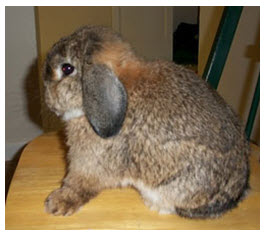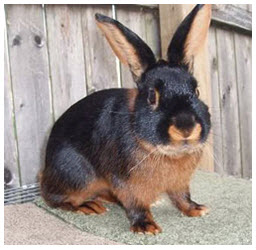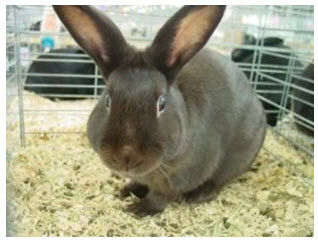Recognizing Rabbit Color Patterns. Learn the basics about rabbit color patterns and find information about rabbit coat color genetics.
There are dozens of rabbit colors out there. Hundreds. If you add up every possible combination and count it as a separate color, you might come up with thousands. And yet, here’s the good news: with a little knowledge and some practice, you can learn to identify every one of those colors in a fairly short time.

In the December 2012 issue of the RabbitBreeders.us newsletter (see: Rabbit Coat Colors Genetics Article), we talked about how every rabbit variety is one of four base colors. Every single rabbit color has a black, blue, chocolate, or lilac base. That helps us break down all those hundreds of colors into four simple groups. Now I’m going to break them a different way. This is even simpler: we can categorize every single rabbit color into one of three groups based on pattern.
There are only three rabbit color patterns. Colors vary in shade, base color, and whatnot, but they all fit under one of three patterns.
Rabbit Pattern 1: Agouti
 The first pattern is called Agouti. This is the “normal” rabbit color pattern. Wild rabbits are agouti. The colors we call chestnut and chinchilla are agouti. Notice that they have white markings on the belly, chin, tail, eyes, nostrils and ear-insides. Presence of those markings is your first clue that a rabbit might be an agouti. Now look at the top color, the color of the rabbit’s back. It’s not a solid color, but a beautiful blend of light and dark hairs mingled together. If you blow into an agouti’s coat, you will find that each hair shaft is banded with color, and the hairs form concentric rings of color as they lay flat. Anytime you see ring color, the rabbit is agouti. No questions asked.
The first pattern is called Agouti. This is the “normal” rabbit color pattern. Wild rabbits are agouti. The colors we call chestnut and chinchilla are agouti. Notice that they have white markings on the belly, chin, tail, eyes, nostrils and ear-insides. Presence of those markings is your first clue that a rabbit might be an agouti. Now look at the top color, the color of the rabbit’s back. It’s not a solid color, but a beautiful blend of light and dark hairs mingled together. If you blow into an agouti’s coat, you will find that each hair shaft is banded with color, and the hairs form concentric rings of color as they lay flat. Anytime you see ring color, the rabbit is agouti. No questions asked.
Rabbit Pattern 2: Tan
 You know what the Tan breed looks like, right? Gorgeous solid black on the top, with reddish markings underneath? The Tan breed is one example of the tan color pattern, but there are others. Otters are also tan pattern. So are Silver Martens. Let me point out a couple of things to help you identify this pattern:
You know what the Tan breed looks like, right? Gorgeous solid black on the top, with reddish markings underneath? The Tan breed is one example of the tan color pattern, but there are others. Otters are also tan pattern. So are Silver Martens. Let me point out a couple of things to help you identify this pattern:
Notice that the tan pattern colors have markings in all the same places that the agouti pattern colors do. Tans, like agoutis, have light colored markings (from orange to cream to white) on the belly, tail, chin, nostrils, eyes, and ears. They also have a light “triangle” marking at the nape of the neck. When you see these markings, you know that the rabbit must be a tan or an agouti. In order to tell which one, you look at the top color across the rabbit’s back.
Tan pattern colors have a fully solid top color. There’s no blend of hair colors here. The top color might be black. It might be blue. It might be chocolate, lilac, tortoise, or sable. But it’s not going to be chinchilla. It’s never going to be chestnut. Each hair will be just one color, not have bands. You’ll never see ring color on a tan pattern coat.
Rabbit Pattern 3: Self
 Self is the easiest one. A self rabbit does not have the markings on the underside. A self rabbit is essentially the same color all over. Blacks are selfs. So are chocolates, lilacs, and blues.
Self is the easiest one. A self rabbit does not have the markings on the underside. A self rabbit is essentially the same color all over. Blacks are selfs. So are chocolates, lilacs, and blues.
Tortoises are also selfs. So are Siamese sables and smoke pearls and sable points. These rabbits have some shading. For instance, the nose on a sable is darker than the back, which is darker than the sides of the body. However, here’s the important thing: every single hair is only one color. There’s no banding on the hair shaft itself. The color might fade near the skin, but there’s no switching from black to red on a single hair like there is on a Chestnut Agouti coat. If you take a square-inch patch of hair anywhere on the bunny, each hair will be about the same color as those around it. That’s the mark of a self.
Quick ID Checklist:
1. Does the rabbit have agouti/tan markings? If no, it’s a self.
2. If the rabbit does have markings, does it have ring color over the back? If so, it’s an agouti. If not, it’s probably a tan. Also check the outer edges of the ears. If it has darker “lacing” on the tips of the ears, it’s an agouti, period, even if it doesn’t have ring color.
3. If it does have markings, but does not have ring color or ear lacing, and every hair on the non-marked areas is the same color from tip to base (allowing for fading near the skin), you almost certainly have a tan pattern!
Two Cautions:
Whites. Ruby-eyed and blue-eyed whites look like selfs, but they may not be. You can’t tell the pattern on a white rabbit. Genetically, white rabbits have a pattern, but the white gene stripped away all the color so you can’t tell what it is.
A similar caution goes for marked colors such as broken and Dutch. These rabbits have Agouti, Tan, or Self patterns same as any other, but they’re missing color in certain areas, causing the Dutch or broken markings. If color is missing where you need to look for markings or ring color, it can be hard to tell which pattern these guys are.
Want to learn more about Rabbit Color Patterns?
Rabbit Color Genetics becomes more and more fascinating the deeper you study it. If you’re interested in discovering more about this important topic, and how to practically apply it to your advantage in your breeding program, check out “A Book About Bunny Colors,” the practical breeder’s guide to rabbit coat color. Written in easy language, this book places emphasis on the “what happens” with coat color genetics, not all the scientific why’s and how’s. It uses lots of charts and photos to help you grasp the information, and spells out how to apply it in your breeding. Check out the list of features below, and then grab your copy to unlock the mysteries of rabbit coat color!
Photo credits in this article by TC farms and FS Rabbitry.

